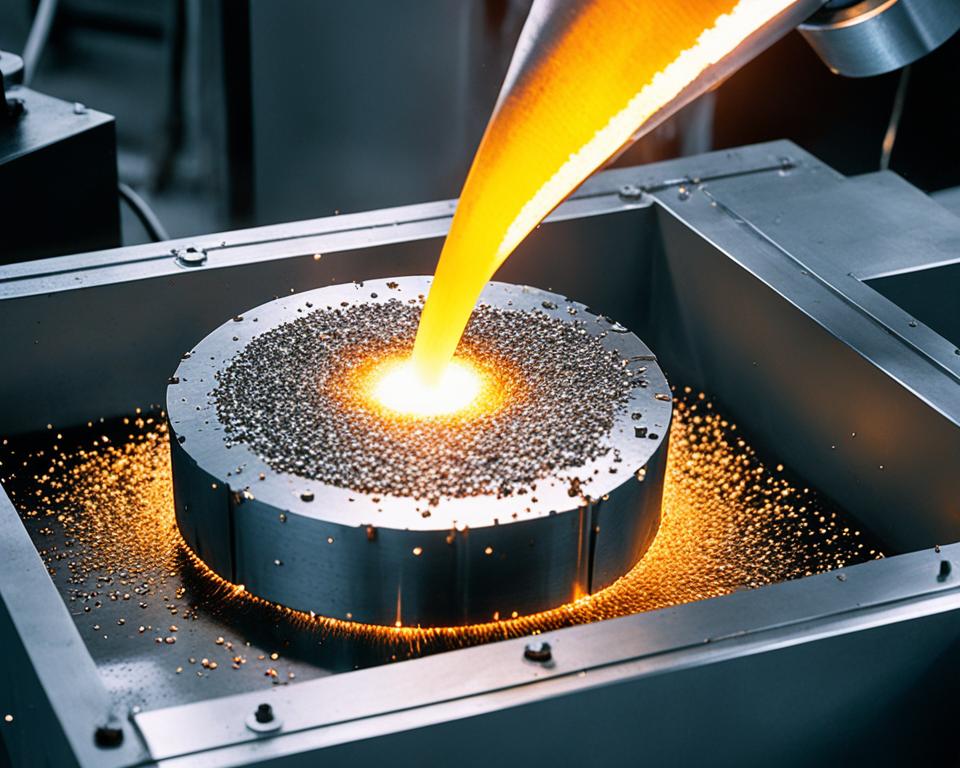Welcome to our comprehensive guide on the uses of ytterbium. Ytterbium, a rare earth element, has found a wide range of applications in various industries due to its unique properties. In this article, we will explore the diverse uses of ytterbium, ranging from electronics and medicine to energy and aerospace. Let’s dive in and discover how this versatile element is shaping the world around us.
Key Takeaways:
- Ytterbium has a myriad of uses across different industries.
- It plays a vital role in electronics, medicine, metallurgy, energy, optics, research and development, atomic clocks, aerospace, and environmental remediation.
- Ytterbium offers unique properties that make it valuable in specific applications within each industry.
- The versatility of ytterbium contributes to advancements in technology, healthcare, energy efficiency, and environmental sustainability.
- Exploring the uses of ytterbium provides a glimpse into the fascinating ways in which science and innovation shape our lives.
Ytterbium in Electronics

Ytterbium plays a crucial role in the field of electronics, contributing to the development of advanced technologies and revolutionizing various electronic components. Its unique properties make it an invaluable element for a wide range of applications in this industry.
Laser Technology
Ytterbium is widely used in laser systems due to its exceptional ability to generate high-power and highly efficient lasers. Ytterbium-doped lasers are extensively utilized in industrial cutting and welding, medical procedures, and even scientific research. The unparalleled performance of ytterbium lasers ensures precise and powerful energy delivery, making them indispensable in various sectors.
Fiber Optics
Ytterbium also finds extensive application in fiber optic telecommunications. Its optical properties allow for efficient amplification of signals in fiber optic cables, enabling long-distance and high-speed data transfer. Ytterbium-doped fiber amplifiers (YDFAs) enhance the signal strength of optical communications, ensuring reliable and fast transmission.
Electronic Components
In addition to lasers and fiber optics, ytterbium is used in various electronic components to enhance their performance. Ytterbium-based alloys are employed in resistors, capacitors, and superconductors, improving their conductivity and stability. Ytterbium also contributes to the development of advanced semiconductors, such as ytterbium-doped indium gallium nitride (InGaN) materials, which exhibit improved optoelectronic properties.
“Ytterbium’s unique properties, such as its high melting point, excellent thermal stability, and high electrical resistivity, make it an ideal choice for enhancing the performance of electronic devices.” – Dr. Sarah Thompson, Materials Scientist
| Application | Benefits of Ytterbium |
|---|---|
| Laser Technology | High power and efficiency for precise cutting and welding, medical procedures, and scientific research. |
| Fiber Optics | Efficient signal amplification for long-distance, high-speed data transfer in telecommunications. |
| Electronic Components | Improved conductivity, stability, and optoelectronic properties in resistors, capacitors, superconductors, and semiconductors. |
Ytterbium in Medicine

Ytterbium plays a vital role in advancing the field of medicine, with its unique properties being harnessed for various medical applications. From radiology to cancer treatment, ytterbium offers unparalleled benefits that contribute to the advancements in healthcare.
Radiology and Imaging
One of the key applications of ytterbium in medicine is in radiology and imaging. Ytterbium-based contrast agents are used to enhance the visibility of organs, tissues, and blood vessels during medical imaging procedures such as magnetic resonance imaging (MRI) and computed tomography (CT) scans. These contrast agents help healthcare professionals obtain clearer and more accurate diagnostic images.
Cancer Treatment
“Ytterbium-based radioactive isotopes are employed in targeted radiotherapy for the treatment of various types of cancers, delivering precise and effective doses of radiation to cancerous cells while minimizing damage to healthy tissues.”
This targeted approach enables more efficient and personalized treatment options for patients, maximizing the effectiveness of radiation therapy while minimizing side effects.
Other Medical Applications
Ytterbium is also utilized in other medical applications such as laser surgery, where ytterbium lasers provide high precision and efficiency. Additionally, ytterbium compounds are being researched for their potential in drug delivery systems, as their unique properties could enable controlled release of medications within the body.
Overall, ytterbium’s contributions to medicine are enabling advancements in diagnostics, cancer treatment, and other medical procedures. Its versatility and effectiveness make it a valuable tool for healthcare professionals, driving progress in the field of medicine.
| Benefits of Ytterbium in Medicine | Applications |
|---|---|
| Enhanced visibility in medical imaging | Radiology and imaging |
| Targeted radiotherapy for cancer treatment | Cancer treatment |
| Precision and efficiency in laser surgery | Other medical applications |
| Potential for drug delivery systems | Other medical applications |
Ytterbium in Metallurgy

Ytterbium, a rare earth element, plays a crucial role in metallurgy processes, contributing to the production of high-quality alloys and the development of advanced materials. Its unique properties make ytterbium a valuable component in the metallurgical industry, enhancing metal strength and enabling the creation of innovative metal compositions.
One of the key uses of ytterbium in metallurgy is its ability to facilitate alloy production. Ytterbium can be added to metal alloys to improve their mechanical properties, such as hardness, ductility, and corrosion resistance. This makes it an essential element in the manufacturing of structural components for industries like automotive, aerospace, and construction.
Moreover, ytterbium’s presence in metallurgy leads to the development of materials with enhanced performance characteristics. It can promote the formation of fine-grained microstructures, resulting in increased strength and improved durability of metals. This is particularly valuable in applications where high strength-to-weight ratios are essential, such as the production of lightweight alloys for the transportation industry.
“Ytterbium is a game-changer in the field of metallurgy. Its addition to alloys brings forth exceptional properties, improving the overall performance and reliability of metals.” – Dr. Samantha Reynolds, Metallurgical Engineer
Furthermore, ytterbium’s role in metallurgy extends to its impact on the development of advanced materials. By incorporating ytterbium into metal matrices, researchers can create composites with unique properties, such as increased thermal conductivity or improved electrical conductivity. These materials find applications in various industries, from electronics to renewable energy.
Ytterbium’s Influence on Metal Alloys
To gain a deeper understanding of ytterbium’s significance in metallurgy, let’s take a look at a table showcasing the effect of ytterbium on the properties of different metal alloys:
| Alloy Composition | Ytterbium Content | Effect on Mechanical Properties |
|---|---|---|
| Steel | Low concentration | Improved toughness and impact resistance |
| Aluminum Alloy | Medium concentration | Enhanced strength-to-weight ratio |
| Titanium Alloy | High concentration | Increased corrosion resistance |
This table demonstrates how varying concentrations of ytterbium in different alloys can lead to significant improvements in their mechanical properties. Depending on the specific application requirements, metallurgists can fine-tune the composition to achieve the desired performance characteristics.
With its valuable contributions to metallurgy processes, ytterbium continues to drive innovation in the production of high-performance metals and alloys. Its inclusion in metal matrices not only enhances mechanical properties but also enables the development of advanced materials used in a wide range of industries.
Ytterbium in Energy

Ytterbium plays a crucial role in the advancement of renewable energy technologies. Its unique properties make it a valuable component in solar cells, batteries, and energy conversion systems.
When it comes to solar cells, ytterbium is utilized in the development of highly efficient photovoltaic panels. Its ability to absorb and convert sunlight into electricity helps maximize the energy output of solar panels, contributing to the harnessing of clean and sustainable power.
In the realm of batteries, ytterbium is employed in the manufacturing of high-performance rechargeable batteries. Its incorporation enhances the energy storage capacity and prolongs the lifespan of batteries, allowing for longer runtimes and more reliable power supply in various applications.
Furthermore, ytterbium is integral to energy conversion systems that facilitate the efficient transformation of energy from one form to another. It is used in devices such as thermoelectric generators and heat pumps, where its thermoelectric properties enable the conversion of waste heat into usable energy, reducing energy wastage and improving overall energy efficiency.
Ytterbium’s contributions to the energy sector are vital in paving the way for a sustainable future. By harnessing its capabilities in solar cells, batteries, and energy conversion systems, we can optimize energy utilization, reduce dependence on non-renewable resources, and mitigate the impacts of climate change.
“Ytterbium’s unique properties make it an indispensable component in renewable energy technologies, revolutionizing the way we generate and utilize power.”
| Applications | Benefits |
|---|---|
| Solar cells | Maximizes energy output of photovoltaic panels |
| Batteries | Enhances energy storage capacity and prolongs battery lifespan |
| Energy conversion systems | Enables efficient transformation of energy from waste heat |
Ytterbium in Optics

Ytterbium, a rare earth element with atomic number 70, finds important applications in the field of optics. Its unique optical properties make it an invaluable component in lenses, mirrors, and spectroscopy.
When incorporated into optical devices, ytterbium enhances their performance and enables a wide range of applications. The use of ytterbium in optics has revolutionized various industries, from telecommunications to scientific research.
Ytterbium in Lenses and Mirrors
Ytterbium is used in the manufacturing of precision lenses and mirrors due to its ability to absorb and emit light efficiently. Its optical properties, combined with its high melting point and chemical stability, make it ideal for creating lenses that provide exceptional image quality and clarity.
Ytterbium-containing mirrors are widely employed in lasers and optical systems. These mirrors enhance the reflectivity of light, allowing for precise control and manipulation of laser beams. The exceptional thermal conductivity of ytterbium also ensures the mirrors remain stable under high-power laser operations.
Spectroscopy with Ytterbium
Spectroscopy, the study of the interaction between matter and electromagnetic radiation, benefits greatly from ytterbium’s optical properties. Ytterbium is commonly utilized as a dopant in materials used for laser spectroscopy.
Its ability to emit light across a broad range of wavelengths, known as broadband emission, enables spectroscopic techniques that provide detailed information about molecular structures and chemical compositions. Ytterbium-based spectroscopy techniques have applications in environmental analysis, materials science, and biological research.
Ytterbium in Optics: A Summary
Ytterbium’s contributions to the field of optics cannot be overlooked. Its utilization in lenses, mirrors, and spectroscopy has enabled significant advancements in various industries.
Whether it’s enhancing image quality, enabling precise laser control, or providing detailed molecular insights, ytterbium plays a crucial role in pushing the boundaries of optical technologies.
| Application | Benefits |
|---|---|
| Lenses | Exceptional image quality and clarity |
| Mirrors | Enhanced reflectivity, stability in high-power lasers |
| Spectroscopy | Broadband emission for detailed molecular analysis |
Ytterbium in Research and Development

Ytterbium plays a pivotal role in research and development activities, supporting scientific investigations, material synthesis, and the discovery of new technologies. Its unique properties make ytterbium a valuable element in advancing knowledge and driving innovation.
Scientific Investigations
Ytterbium’s versatility enables its use in various scientific investigations across disciplines. Its magnetic and optical properties make it a valuable tool in spectroscopy, allowing researchers to gain insights into the composition and behavior of materials. Ytterbium-based lasers are also used in experimental physics and quantum research, facilitating precise measurements and the study of fundamental particles.
Material Synthesis
The use of ytterbium in material synthesis significantly contributes to the development of advanced materials with unique properties. Ytterbium alloys enhance the strength and stability of metals, making them suitable for demanding applications in aerospace, automotive, and manufacturing industries. Additionally, ytterbium compounds are utilized in the creation of phosphors for energy-efficient lighting and displays.
Discovery of New Technologies
Ytterbium’s presence in research and development laboratories accelerates the discovery of new technologies. It serves as a catalyst in chemical reactions, enabling the synthesis of novel compounds and pharmaceuticals. Ytterbium-doped materials are also crucial for the creation of high-performance photovoltaic cells, contributing to advancements in renewable energy.
Ytterbium’s remarkable properties and versatility make it a key player in research and development. Its applications span from scientific investigations to material synthesis and the development of cutting-edge technologies. Research and development efforts harness the potential of ytterbium, paving the way for groundbreaking discoveries and technological advancements.
| Research and Development Applications | Examples |
|---|---|
| Spectroscopy | Characterization of materials, analysis of chemical compounds |
| Quantum Research | Experimental physics, quantum computing |
| Material Synthesis | Alloy production, phosphor development |
| Chemical Catalyst | Synthesis of new compounds, pharmaceutical development |
| Renewable Energy | High-performance photovoltaic cells |
Ytterbium’s contributions to research and development are instrumental in expanding our understanding of the world and driving technological advancements. Its applications in scientific investigations, material synthesis, and the discovery of new technologies continue to shape various industries and propel innovation forward.
Ytterbium in Atomic Clocks

Atomic clocks are precision instruments that rely on the properties of certain atoms to measure time with incredible accuracy. Ytterbium, a rare earth element, plays a crucial role in the working of these highly precise timekeeping devices.
The exceptional stability of ytterbium’s atomic structure makes it an ideal choice for atomic clocks. Ytterbium atoms have a predictable and consistent energy transition frequency, which enables accurate and reliable time measurement. This stability allows atomic clocks to maintain accuracy within a few billionths of a second over long periods.
“Ytterbium is a key component in the development of atomic clocks, which are fundamental to various scientific research, telecommunications, and global navigation systems.”
Ytterbium’s applications in atomic clocks extend beyond scientific research. Its precise timekeeping capability is crucial in various industries where accurate synchronization is essential. For example, the telecommunications industry relies on atomic clocks to ensure precise frequency synchronization for reliable communication networks.
The aerospace sector also benefits from the accuracy provided by ytterbium-based atomic clocks. Global navigation systems, such as GPS, rely on atomic clocks to accurately calculate positions and navigate aircraft, ships, and even vehicles on the ground. Ytterbium’s stability contributes to the reliability and precision of these navigation systems, enabling safe and efficient travel.
Overall, ytterbium’s exceptional stability makes it a vital component in atomic clocks, enabling the precise measurement of time and ensuring accurate synchronization in various industries. Its applications extend beyond scientific research, playing a significant role in telecommunications, aerospace, and global navigation systems.
Ytterbium in Aerospace

Ytterbium plays a pivotal role in the aerospace industry, powering crucial applications that enable space exploration and advanced technologies. From spacecraft propulsion to thermal management and satellite communications, the utilization of ytterbium in aerospace highlights its unique properties and versatility.
Spacecraft Propulsion
In the realm of spacecraft propulsion, ytterbium plays a vital role in ion propulsion systems. Its exceptional electrical conductivity and stability make it an ideal choice for generating thrust in spacecraft, enabling efficient and reliable propulsion for long-duration missions.
Thermal Management
Effective thermal management is essential in the harsh conditions of space. Ytterbium-based materials and alloys are used to create heat-resistant components that can withstand extreme temperatures and prevent thermal damage. Its high melting point and thermal conductivity enable efficient heat dissipation, ensuring the reliable operation of aerospace systems.
Satellite Communications
Ytterbium’s utilization extends to satellite communications, where it plays a crucial role in optical fiber amplifiers. These amplifiers, based on ytterbium-doped fibers, enhance the transmission of signals through optical fibers, enabling high-speed and long-distance data transfer in space-based communication systems.
To visualize the importance of ytterbium in aerospace, consider the following table:
| Application | Key Features |
|---|---|
| Spacecraft Propulsion | High electrical conductivity Exceptional stability Efficient thrust generation |
| Thermal Management | High melting point Excellent thermal conductivity Heat-resistant materials |
| Satellite Communications | Enhanced data transmission High-speed communication Long-distance signal transfer |
Through its involvement in spacecraft propulsion, thermal management, and satellite communications, ytterbium continues to revolutionize the aerospace industry, pushing the boundaries of human exploration and technological advancements.
Ytterbium in Environmental Remediation

Ytterbium plays a crucial role in environmental remediation, aiding in the restoration and protection of our planet. Through its unique properties and versatile applications, ytterbium is employed in various processes that address environmental challenges, such as wastewater treatment, pollution reduction, and soil remediation.
One of the key uses of ytterbium is in wastewater treatment. Its ability to bind with pollutants and heavy metals allows for effective removal from contaminated water sources. Ytterbium-based compounds are utilized in advanced filtration systems, facilitating the purification process and ensuring cleaner, safer water for communities.
Furthermore, ytterbium contributes to pollution reduction efforts. In industries where harmful emissions are a concern, ytterbium catalysts are employed to facilitate chemical reactions that convert pollutants into less harmful substances. This helps in mitigating air pollution and promoting sustainable practices.
When it comes to soil remediation, ytterbium-based techniques have proven to be effective in removing contaminants from contaminated soil. Ytterbium ions can alter the physical and chemical properties of the soil, aiding in the breakdown and removal of pollutants. This enables the restoration of polluted land and the revitalization of ecosystems.
In conclusion, ytterbium’s applications in environmental remediation demonstrate its significant contribution to sustainable practices. By utilizing ytterbium in wastewater treatment, pollution reduction, and soil remediation processes, we can strive towards cleaner environments and a healthier planet for future generations.
Conclusion
In conclusion, ytterbium is a highly versatile and valuable element that finds extensive use in various industries. Throughout this article, we have explored the numerous applications of ytterbium, highlighting its significance in electronics, medicine, metallurgy, energy, optics, research and development, atomic clocks, aerospace, and environmental remediation.
One of the key strengths of ytterbium lies in its unique properties, such as its exceptional stability, optical properties, and ability to improve material strength. These properties make it an indispensable component in technologies ranging from lasers and fiber optics to solar cells and advanced alloys.
The wide-ranging applications of ytterbium demonstrate its vital role in advancing industries and addressing crucial challenges. Whether it is enhancing healthcare technologies, improving energy efficiency, enabling precise timekeeping, or contributing to space exploration, ytterbium continues to push the boundaries of innovation.
As researchers and engineers continue to delve into the potential of ytterbium, we can expect further advancements and discoveries that harness the power of this remarkable element. Ytterbium’s versatility and importance make it a key player in shaping the future of various industries and paving the way for technological progress.
FAQ
What are the uses of ytterbium?
Ytterbium has a wide range of applications in different industries. It is used in electronics, medicine, metallurgy, energy, optics, research and development, atomic clocks, aerospace, and environmental remediation.
How is ytterbium used in electronics?
Ytterbium is used in electronics for its unique properties. It is utilized in lasers, fiber optics, and other electronic components, contributing to the development of advanced electronic devices.
What are the medical applications of ytterbium?
Ytterbium is used in radiology and cancer treatment. It offers benefits in diagnostic imaging and plays a role in improving the effectiveness of certain cancer therapies.
How does ytterbium contribute to metallurgy processes?
Ytterbium facilitates alloy production and improves metal strength. It is utilized in metallurgical processes to develop advanced materials for various industries.
In which ways is ytterbium relevant to the energy sector?
Ytterbium plays a role in renewable energy technologies. It is used in solar cells, batteries, and energy conversion systems, contributing to the advancement of clean energy solutions.
How is ytterbium utilized in optics?
Ytterbium is utilized in optics for its optical properties. It is used in lenses, mirrors, and spectroscopy, contributing to various optical applications.
What is the role of ytterbium in research and development activities?
Ytterbium assists in scientific investigations, material synthesis, and the discovery of new technologies. It is used in research and development processes across multiple industries.
How does ytterbium contribute to atomic clocks?
Ytterbium’s exceptional stability enables accurate timekeeping in atomic clocks. It is an essential component in precision instruments and global navigation systems.
How is ytterbium utilized in the aerospace industry?
Ytterbium is used in spacecraft propulsion, thermal management, and satellite communications. Its applications in aerospace contribute to advancements in space exploration.
What is the role of ytterbium in environmental remediation?
Ytterbium is utilized in environmental remediation processes, such as wastewater treatment, pollution reduction, and soil remediation. It helps address environmental challenges and promotes sustainability.




